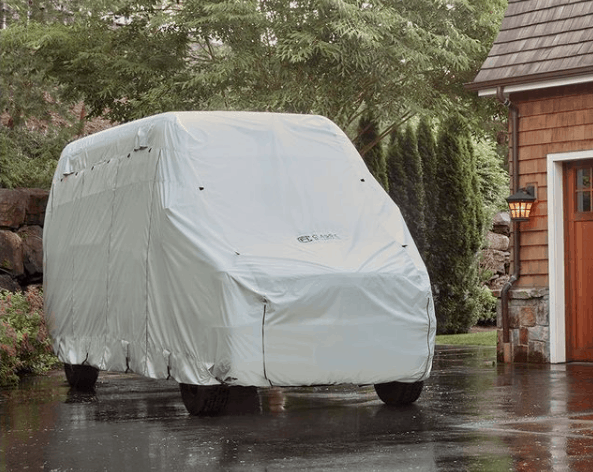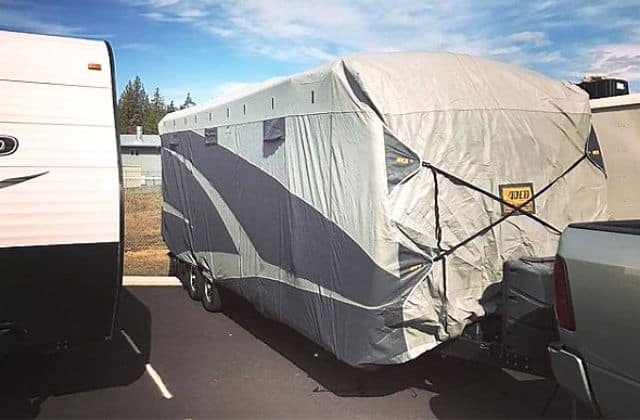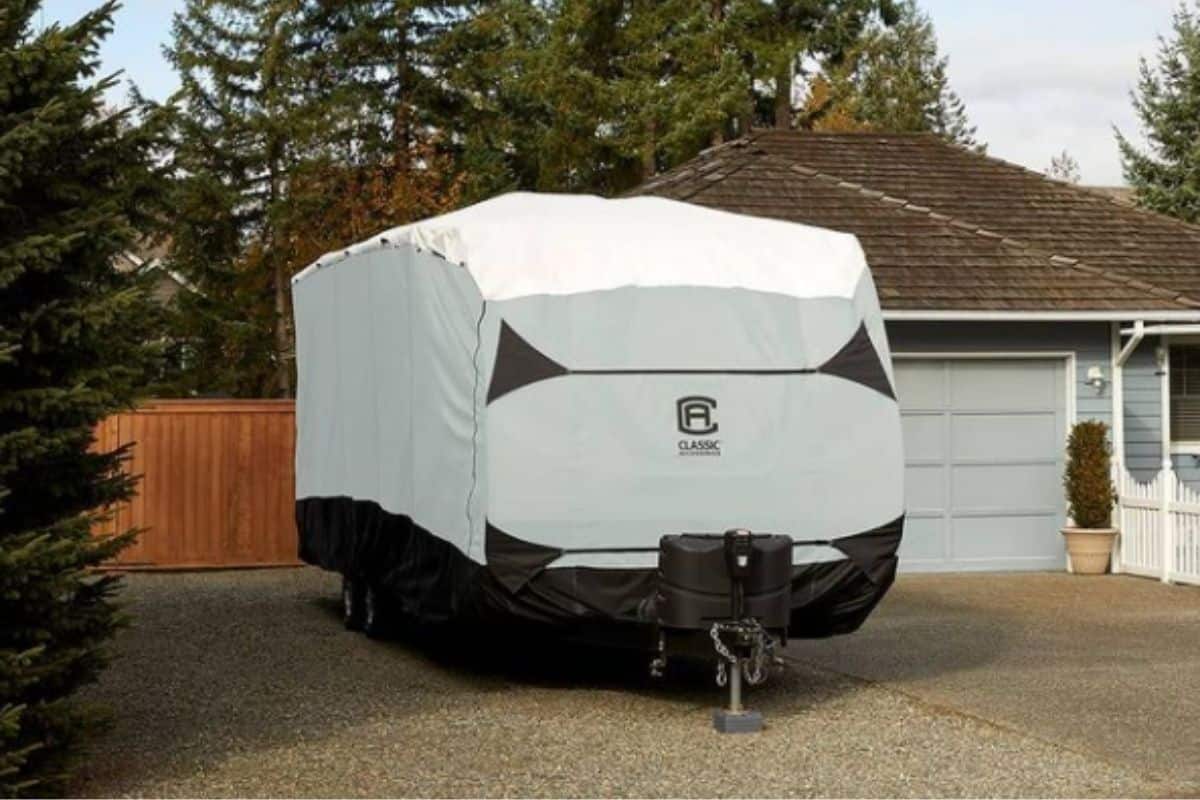Even if you love RVing and use your RV on a regular basis, your camper will still spend a lot of time parked in storage and exposed to the elements.
Which can damage the RV and shorten its usable life considerably.
Because of this, it’s important to try and protect your RV from the harsh elements as much as possible.
Which is why so many RVers use RV covers.
But are RV covers really a good idea?
RV covers are a great way to protect and care for an RV, as they help to reduce the RV’s exposure to harsh elements, such as UV light and moisture, which can damage the RV over time and shorten its life.
Ideally, an RV cover should be used whenever the RV is going to be stored or parked for an extended period of time to help protect the RV.
There is a lot more to know about RV covers though beyond just whether or not they are a good idea.
So if you’re thinking about buying an RV cover or have an RV you want to protect, keep reading.
As we go into great detail about RV covers as well as all their pros and cons.
Pros and Cons of RV Covers
When it comes to RV covers there are way more pros than cons.
But it’s important to understand everything there is to know about them including both their advantages and disadvantages so that you can make an informed decision for yourself.
RV Cover Pros
There are many great reasons to use an RV cover.
So we compiled this list to highlight some of the best advantages of using an RV cover on your camper.
- One of the most important advantages to an RV cover is all the protection it offers from the elements including sun, rain, wind, and snow while your RV is parked outside.
- RV covers protect your RV from harsh UV light which can damage the entire exterior of your RV and especially your RV rubber roof.
- RV covers are a cheap way to protect your RV compared to more expensive options such as renting covered or enclosed parking which can often cost $100 or more a month.
- Helps to keep the camper clean which means less time washing your RV and more time enjoying it.
- RV covers do a great job of protecting your investment as well as helping to maintain the value of the RV if you decide to sell it in the future.
- Helps to reduce exterior maintenance on the RV by covering critical components such as the rubber roof, caulking, gaskets, and trim, reducing the amount of exterior repair and maintenance needed on the RV.
RV Cover Cons
There are not a lot of cons to RV covers as long as you’re using one properly, however, in order to provide a more balanced review of RV covers, it’s important to mention at least some of the minor cons or inconveniences of an RV cover.
- Quality RV covers can be on the expensive side, especially if you have a larger RV often costing several hundred dollars or more.
- RV covers can be bulky and time-consuming to put on and take off when storing and taking your RV out of storage.
- RV covers are pretty large and can be hard to store when not in use, as they take up a lot of space.
- If you live in an area with a lot of snow in the winter they can be especially challenging to remove when they are covered with snow and ice.
How to Use an RV Cover
RV Cover Installation
While it might seem pretty self-explanatory on how to use an RV cover, there are some best practices that will help make it easier when using and storing an RV cover.
The first thing you want to remember is that RV covers can be pretty heavy and awkward to handle, especially if you’re trying to put the RV cover on by yourself.
So instead of trying to lug the entire cover all at once to the top of the RV, it’s best to remove it from its storage container or bag and roll it out along the side of the RV.
Then once it’s laid out, head to the top of your camper and use one of the cover’s long straps to slowly and carefully pull each section of the cover to the top of the RV.
Once the cover has been spread out on the top of your RV by stretching the cover from front to back and then from side to side, head down to the ground and use at least a 6-foot ladder to pull the cover down all sides of the RV.
Then the only thing left to do is to secure the straps or hems under and around the RV and use the tie-downs to secure the cover if your RV cover came with them.
RV Cover Storage
While RV covers do typically come with some type of storage bag, once you have removed the RV cover from the bag, it can be nearly impossible to try and get the cover back inside again.
So instead of struggling and fighting to use the included storage bag, consider purchasing a large rubber trash can instead, to use as its storage container, as this will make it much easier to transport and store the RV cover when not in use.
Just make sure you buy a big enough trash can to accommodate your RV cover.
Usually, a 64-gallon rubber trash can is large enough but depending on how big your RV and cover are you might need to get a 96-gallon rubber can.
Also, when choosing a rubber trash can, don’t forget to buy one with wheels, as this will make it much easier to move the cover around, as they can often weigh 50 pounds or more.
Are RV Covers Waterproof?

Most RV covers are waterproof but some of the cheaper RV covers might not be.
This is why it’s so important when buying an RV cover to purchase a quality cover that specifically states it’s waterproof.
As moisture and water are some of the most damaging elements to an RV, leading to a wide range of problems and issues on both the exterior as well as the interior of the RV if the water is allowed to pull and collect on the RV.
Do RV Covers Trap Moisture and Cause Mold?
Most RV covers are made from polypropylene fabric or polyester which is a breathable material with tiny holes allowing the RV cover to breathe.
These tiny holes in the fabric allow moisture trapped under the cover to evaporate but don’t allow water droplets to penetrate.
And because the RV cover is breathable, it is very unlikely to develop any mold or mildew issues under the cover.
However, it might be possible to develop a mold or mildew issue if your RV is parked in an area with little to no airflow or if anything is placed against the RV cover which might block and prevent air to pass through the cover.
You can also develop a mold or mildew issue if you choose to cover your RV with a tarp.
As tarps are not made from a breathable material and can allow moisture to become trapped underneath them which can potentially cause a mold or mildew issue.
This is why you should never use a tarp as a long-term cover for an RV and should only be used for short periods of time in case of emergency.
Do RV Covers Cause Damage?
A common misconception about RV covers is they can actually cause damage to your RV.
But if you buy a quality non-abrasive and breathable RV cover properly sized for your RV, this couldn’t be further from the truth.
As RV covers are actually one of the best ways to protect the RV from harmful UV damage and moisture.
There are a few things you should do though when buying and using an RV cover to make sure that you get the maximum amount of protection from your RV cover and reduce the likelihood of damage caused by an RV cover.
- One of the most common mistakes RVers make when using an RV cover is that they don’t invest in a quality RV cover and instead opt for some cheap cover or tarp that can actually do more harm than good. So when buying your RV cover make sure you’re buying a quality cover from a quality brand like Classic Accessories or ADCO.
- In order for an RV cover to provide maximum protection its also important to buy the right size RV cover so that it fits the overall length and width of your RV snuggly, this also helps to minimize the risk of the cover billowing in the wind which can potentially cause damage to the RV.
- When purchasing an RV cover make sure you choose a cover that is both waterproof and breathable which will not only keep the water off and out of your RV but will also reduce the likelihood of developing a mold or mildew issue under the cover.

Should You Cover Your RV in the Summer?
The best thing you can do to help protect and preserve your RV during the hot summer months is to store your RV in a covered or climate-controlled garage.
However, climate-controlled garages large enough to store an RV can be very expensive, so the next best thing to help protect your RV during the summer months is an RV cover.
Because one of the most damaging elements to an RV during the hot summer months is the baking sun and extreme UV light, which can cause paint and plastics to fade, dry out, and crack and can even cause your rubber roof to degrade over time.
So to help reduce the damaging effects of the hot sun and extreme UV light during the summer months it’s best to use a breathable non-abrasive full RV cover to cover your coach up during the summer.
And if you’re concerned about the extreme temperatures inside your RV while it’s covered up during the summer months, it’s important to realize your RV is going to get hot sitting in the sun regardless of whether you have a cover on it or not, just like a car heats up during a hot summer day.
Just make sure when you’re choosing an RV cover that it’s breathable and you regularly check on your RV to ensure there are no issues while it’s being stored during the summer, which you should be doing anyway.
Should You Cover Your RV in the Winter?
Yes, you should cover your RV in the winter as well as all other seasons with a quality RV cover while the RV is being stored to help protect your investment and the life of the RV.
If you’re parking your RV outside and want to preserve your RV and keep it looking its best you should always cover your RV when you store it for extended periods of time.
Not only will an RV cover help to keep your RV looking its best for longer but it will also go a long way in keeping the elements on the outside of the coach where they belong.
By protecting the roof membrane, as well as the caulking and seems of an RV, which can be especially vulnerable to water penetration during the winter months.
Why Do You Cover RV Tires?
It’s a good idea to cover your RV tires with RV tire covers like these top sellers on Amazon because it helps protect and preserve your RV tires to get as much life out of them as possible.
Because let’s face it there is nothing cheap about RV tires.
But if you’re still wondering why you would specifically cover your RV tires while parked, below are the top benefits of covering your tires.
- RV tire covers help to protect the tires from harmful UV light which can dry out and break down the tire over time significantly shorting the life of the tire.
- Tire covers can also go along way in preserving your tires by blocking out most of the harmful weather which can wear on your RV tires over time.
- Finally, RV tire covers can also help to prevent premature cracking of the tire sidewalls ensuring you get every last bit of usefulness out of your RV tires.
Recent Posts
When cruising down the highway in your RV, the last thing you want is a tire blowout! Not only is it dangerous, but RV tire replacement isn't cheap, costing $200 to $300 per tire. The good news,...
Nothing ruins an RV adventure faster than a breakdown with no way to fix it. Because of this, every RVer should have a well-stocked RV tool kit for those unexpected roadside emergencies and campsite...

